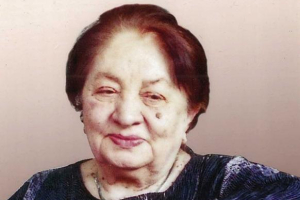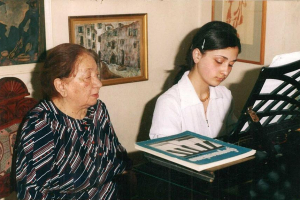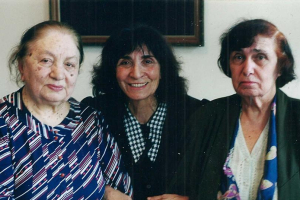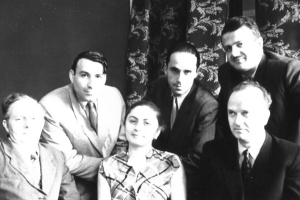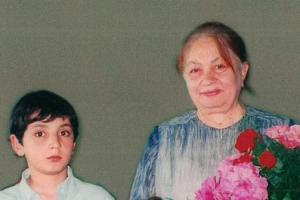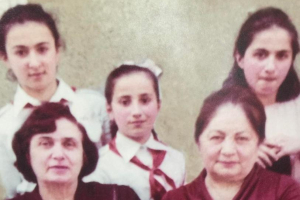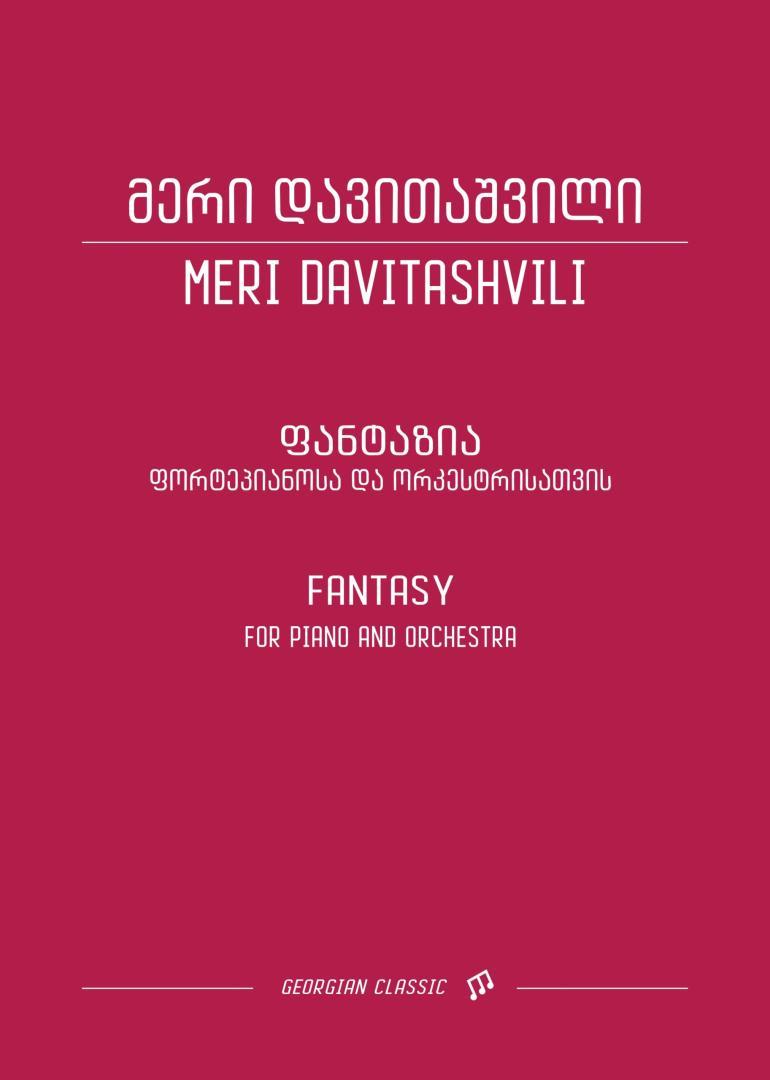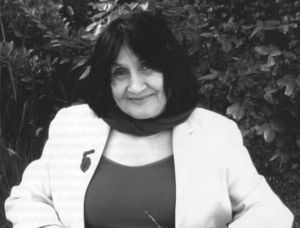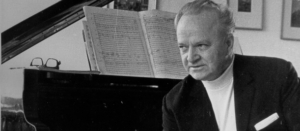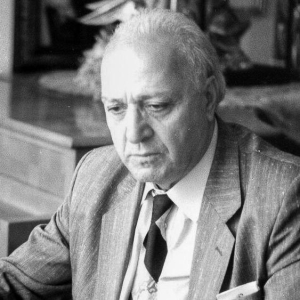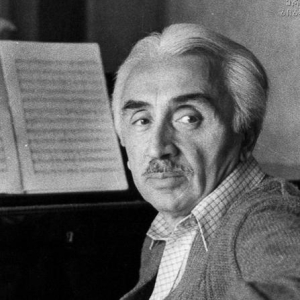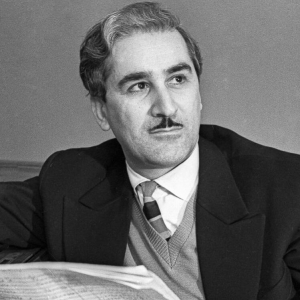Meri
Davitashvili
Meri Davitashvili
(1924 – 2014)
Mary (Mariam) Davitashvili — Georgian Composer, Teacher, one of the founders of Georgian children’s music.
Honored Art Worker of Georgia (1960), People’s Artist of the Georgian SSR (1979), Laureate of the Shota Rustaveli State Prize (1981).
Date of birth – March 13, 1924
Place of birth – Tbilisi, Georgia
Date of death – February 17, 2014
Place of death – Tbilisi, Georgia
She is buried in Saburtalo Pantheon of Public Figures – Tbilisi
BIOGRAPHICAL DATA
1946 – Graduated from the Tbilisi State Conservatory named after Vano Sarajishvili, majoring in composition (Andria Balanchivadze’s class);
Since 1973 – Vano Sarajishvili Tbilisi State Conservatory Pedagogue;
Since 1994 – Professor of Vano Sarajishvili Tbilisi State Conservatory;
AWARDS AND RECOGNITION
1954 – 1968 – Head of the Children’s Section of the Union of Composers of Georgia
1968 – 1992 – Secretary of the Board of the Union of Composers of Georgia and member of the Audit Commission
1968 – 1992 – “Children’s Music Week” – Chairman of the Republican Commission for Musical and Aesthetic Education
Union of Composers of Georgia, Secretary (1968–1992)
Board of the Union of Composers of Georgia, member
1960 – Honored Worker of Georgian Art
1979 – People’s Artist of Georgia
1981 – Shota Rustaveli State Prize
1994 – Yakob Gogebashvili prize
1997 – Order of Honor
2005 – Honorary Citizen of Borjomi
2011 – Honorary Citizen of Tbilisi
Meri Davitashvili
(1924 – 2014)
SELECTED WORKS
MUSIC FOR THE THEATER
1953 – “Sun Wedding” – Ballet (Unfinished) – (Libretto – O. Egadze)
1965 – “Kajana” – Opera In 2 Acts – (Libretto – R. Tabukashvili)
1972 – “Natsarkekia” – Opera In 2 Acts – (Libretto – S. Cheishvili)
ORCHESTRAL MUSIC
1945 – “Gelati” – Symphonic Suite
1945 – “For Peace” – Overture for Symphonic Orchestra
1953 – Symphonic Suite from the Ballet “The Wedding of the Sun”
1954 – “Pioneer Suite” – for Symphonic Orchestra
1965 – “Morning in Bakuriani” – Symphonic Picture
1968 – Symphonic Suite from Motion Pictures
1972 – “Festive Suite” – Suite for Children’s String Orchestra
1981 – Suite for Symphonic Orchestra
1946 – Concerto for Piano and Symphonic Orchestra
1956 – Fantasy for Piano and Symphonic Orchestra
1954 – Poem for Violin and Symphonic Orchestra
CHAMBER-INSTRUMENTAL MUSIC
1945 – “Khorumi” – for Piano
1946 – Nocturnes – for Piano
1946 – Scherzo – for Piano
1948 – Prelude – for Piano
1948 – “Ballad” – for Piano
1949 – “Nocturnes” – for Cello and Piano
1950 – “Aria” – for Violin and Piano
1952 – 4 Pieces for Piano
1952 – “Song” – for Cello and Piano
1962 – Sonatina – for Piano
1962 – “Melody” – for Cello and Piano
1979 – 5 Pieces for Piano
1950 – “Little Trio” – for Flute, Violin and Cello
1983 – Suite for Harpsichord
VOCAL MUSIC
AUTHOR OF MORE THAN 100 CHORAL WORKS. BETWEEN THEM
1950 – “New Georgia” – (text – A. Abashidze)
1951 – “Evening Tbilisi on the Sea” – (text – G. Abashidze)
1958 – “My Tbilisi” – (text – A. Abasheli)
1964 – “Song about Adjara” – (text – G. Grigolashvili)
1974 – “Idyll of Meskheti” – Vocal Cycle – (text – E. Didimamishvili)
1981 – “Spring” – (text – G. Grigolashvili)
1982 – “Ancient Meskheti” – (text – E. Didimamishvili)
AUTHOR OF MORE THAN 200 CHILDREN’S SONGS, INCLUDING:
“Good Morning” – (6 Songs) – (text – M. Mrevlishvili)
“Songs of Toys” – (5 Songs) – (text – M. Mrevlishvili)
“Ana-Bana” – (6 Songs) – (text – M. Mrevlishvili)
“Nine-Eyed Mze” – (5 Songs) – (text – G. Chichinadze)
“Georgian Mze” – (5 Songs) – (text – G. Chichinadze)
FILM AND THEATER MUSIC
AUTHOR OF MUSIC FOR MORE THAN 40 PLAYS. BETWEEN THEM:
“The Girl with the Bow”, “The Nameless Star”, “The Soldier’s Widow”, “Maya Tskneteli”, “Old Romances”, “The Tale of the Deep Forest”, “Arsena Marabdel”, “Kind Neighbors”, “Crying of the Vine”
AUTHOR OF MUSIC FOR MORE THAN 40 CHILDREN’S PLAYS. BETWEEN THEM:
“Puss in Boots”, “Hippie”, “The Adventures of Pinocchio”, “Cinderella”, “Butterfly Girl”. “Gigla is studying”, “The Red-Skins Leader”, “The Power of Good”, “Little Red Riding Hood”, “Cuckoo Clock”, “Dangerous”, “Dachshund Tales”…
FILMOGRAPHY
1958 – “Manana” – director – Shalva Martashvili, Zakaria Gudavadze
1960 – “Papa Gigia” – director – Zakaria Gudavadze
1966 – “Late Bride” – director – Kote Mikaberidze – the film was shot in 1939. Voiceless. Restored in 1966.
ANIMATION
1955 – “Resentment and resentment” – director – Arkady Khintibidze
1957 –”Chkhikvta Vukdini” – director – Arkady Khintibidze
1957 – “Adventure of the right-handed master” – director – Vakhtang Bakhtadze
1958 – “Lying fox” – director – Avenir Khuskivadze
1958 – “Idle” – director – Avenir Khuskivadze
1957 – “Enmity” – director – Arkady Khintibidze
1960 – “Tiger and Donkey” – director – Otar Andronikashvili
1961 – “Niko and Siko” – director – Shalva Gedevanishvili
1962 – “Half Chicken” – director – Arkady Khintibidze
1963 – “Korbuda” – director – Arkady Khintibidze, Gabriel Lavrelashvili
1963 – “Hero” – director – Shalva Gedevanishvili
1965 – “How they built a house” – – director – Shalva Gedevanishvili
1965 – “Sataguri” – director – Otar Andronikashvili
1971 – “The Flea and the Ant” – director – Mikheil Chiaureli. Givi Svanidze
1972 – “Kila Erbo” (“Shattered Dream”) – director – Mikheil Chiaureli, Givi Svanidze
1963 – “Neighbors” – director – Gabriel Lavrelashvili
1977 – “Terdzi Beso” – director – Luis Fernandez
1983 – “The gift of the right-handed master” – director – Vakhtang Bakhtadze
DOCUMENTARY
1957 – “Ilia Chavchavadze”
1959 – “In the footsteps of Mtkvari”
1960 – “My Village”
1961 – “Batumi Botanical Garden”
TELEVISION FILMS
1961 – “Lost Melody”
1963 – “Helping the Dolls”
Meri Davitashvili
(1924 – 2014)
Generations have grown and continue to grow on Meri Davitashvilis’ music. Musicologist Nana Kavtaradze pointed out “If you ask a Georgian youngster who Meri Davitashvili is, they may not be able to respond, but it is enough to start one of her songs, and the child will follow it and continue to sing himself or herself! “ Meri Davitashvili has always been fascinated by different types of music since the beginning of her creative career. Success followed her piano concerto (1946), fantasy for piano and orchestra (1956), poem for violin and orchestra (1954), orchestral suite ballet “The Wedding of the Sun” ( 1953),” “In the Forest” (1965), and her ensembles as well. The piano play “Khorumi” (1945) were gained big popularity, and were performed at the international festivals in Tbilisi and abroad, and it became a regular for pianists’ repertoire.
Meri Davitashvili’s involvement in national poetry was expressed during her creative work, which is represented in the novels of Georgian poets such as Titsian Tabidze, Ioseb Grishashvili, Irakli Abashidze, Murman Lebanidze, and others. Ana Kalandadze’s poetry has a special place in this collection. The composer addresses her lyrics in various stages of her life, revealing the nuanced, of her own world. This is how the vocal cycles “Songs for Me,” “Daria of the Rose,” “Poppy Redness,” “Nino’s nateli” (Light), and others were created. Children’s music holds a significient place in her works. Her contribution in this field consists of small and extensive compositions. Varying from children’s songs to operas.
It is worth mentioning that the composer’s special attention to the children’s world was influenced by a personal matter, her bond with her own child. The chronology of her works also stops us from getting the impression that the author follows the child’s age step by step, gradually complicating the melodic language, the manner of depiction, and the forms. Meri Davitashvili’s first connection with children’s world is represented by song cycles based on the poems of children’s poet Makvala Mrevlishvili: “Good Morning” (1952) and “Toy Songs” (1953). (1955). It was the first union of composer and poet. This tandem became a constant companion of the young generation, and essential issue for their evolution.
In these cycles, the composer creates images in easy language for the youngsters to understand, taking into account the inner nature of the adolescent. The similar spirit can be noticed in piano works written for pupils at distinct periods. Different generations of Georgian composers wrote children’s pieces earlier, but their involvement with this field was irregular. Meri Davitashvili was a composer who constantly focused on children’s music, to which she devoted her entire creative life. With works for children, she developed her own handwriting, a simple, transparent language based on national traditional melodies, rhythm, harmony, and tone. Thus, the composer developed the national children’s “intonation” in Georgian professional music. Meri Davitashvili’s operas, are important achievement of her work in the field of children’s music, which were successfully produced on the stage of the Tbilisi Opera and Ballet Theater. The composer played an important role to the children’s opera. Her works as a theatre composer revealed that music served as a prelude to dramatic productions. Here she grew as a composer- playwright, and her children’s song compositions provided as the platform for presenting the idea in her individual style. In the first lyrical-genre opera “Kajana,” inspired by Niko Lomouri’s (1965) story of the same name, the composer addressed a huge variety of Georgian folklore and developed a sample of the National Children’s Opera.
The opera “Natsarkekia” (1972), based on Georgian fairy tale, is an important piece of Georgian children’s opera. The vivid, mind-blowing faces, the formation of flexible, cinematographic elements of drama, and the colorful orchestration – all brought attention to this work. Meri Datashvili’s name was also famous by music for movies (particularly “Manana Song” from the film “Manana”) and music for cartoons (“Wedding of the Jays”, “Tsuna and Tsrutsuna”, “Flea and Ant”, etc.). According to musicologist Gulbat Toradze, “Meri Davitashvili’s work is well known not only through musical circles, but also across Georgia.” Her iconic children’s songs have become a major part of the creative formation of the younger generation as her simple and virtuous melodies are surrounding our little ones from the cradle.
Musicologist
Tamar Tsulukidze
English Language Translator
Tamar Kharadze



